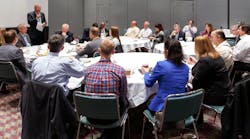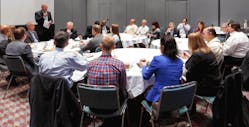At the recent Air-Conditioning Heating and Refrigeration (AHR) Expo in Orlando, Johnson Controls hosted a roundtable discussion among industry experts, examining the need for buildings to be agile to meet the demands of an ever-changing world. Participants agreed that building environments must be more adaptable, integrated and connected than ever before – but there was healthy debate around what new challenges and opportunities are on the horizon. And what they really mean for facility contractors, engineers and owners. The topics of technology, cybersecurity, costs, regulation and sustainability took center stage at the event, but the need to train and attract top talent to the HVAC industry also surfaced throughout.
SEE MORE ABOUT THIS DISCUSSION HERE
Attracting top talent
“We’re in an industry that doesn’t stand still,” said Paige Perilloux, sales manager of Johnson Controls’ Tampa branch. “To keep moving, we have to attract the right talent to keep us moving forward, and we have to help ensure that they receive the right training.”
Perilloux suggested that building industry leaders work with colleges and universities to ensure that cutting-edge training and topical curriculum are the norm for the next generation of tradespeople and professionals.
“A strong educational background will always be part of the equation,” she added. “We have to inspire today’s students. It won’t be long before they are the industry leaders who will be essential to remaining agile in an ever-changing landscape that will be tasked with maximizing technology and driving growth.”
Embracing emerging technologies
People talk a lot about the Internet of Things, but what does it really mean for the HVAC industry?
“It’s less about the technology and more about the outcomes and functionality,” said Nazee Hoglund, vice president – systems product management, Johnson Controls. “As building systems move forward, it’s increasingly important that they communicate with other systems, including mobile phones and other devices. This way we can change the dynamics of our business by providing useful information that improves the business outcome.”
According to Ben Freas, senior research analyst, Navigant, no new technology is perfect, and new systems will have to be carefully monitored to ensure their efficiency. Building owners need to prioritize the collection of data – and make it meaningful – to ensure that information is being used in ways that optimize building efficiency.
Reactions to new regulations
Energy policy has earned attention and momentum in recent years. Ten states have increased the stringency of their building codes; California passed a goal of increasing residential and commercial buildings by 50 percent by the year 2030; and the U.S. Department of Energy has released a record number of appliance and efficiency standards. These are just a few regulatory policy changes worth noting, and participants had much to say about their impact.
“The definition of agile is being able to quickly and gracefully adapt to change,” said Clay Nesler, vice president – energy efficiency and sustainability, Johnson Controls. “That’s what our industry needs to strive for. We need to implement solutions that give us options to leverage new technology and respond to future challenges and opportunities.”









